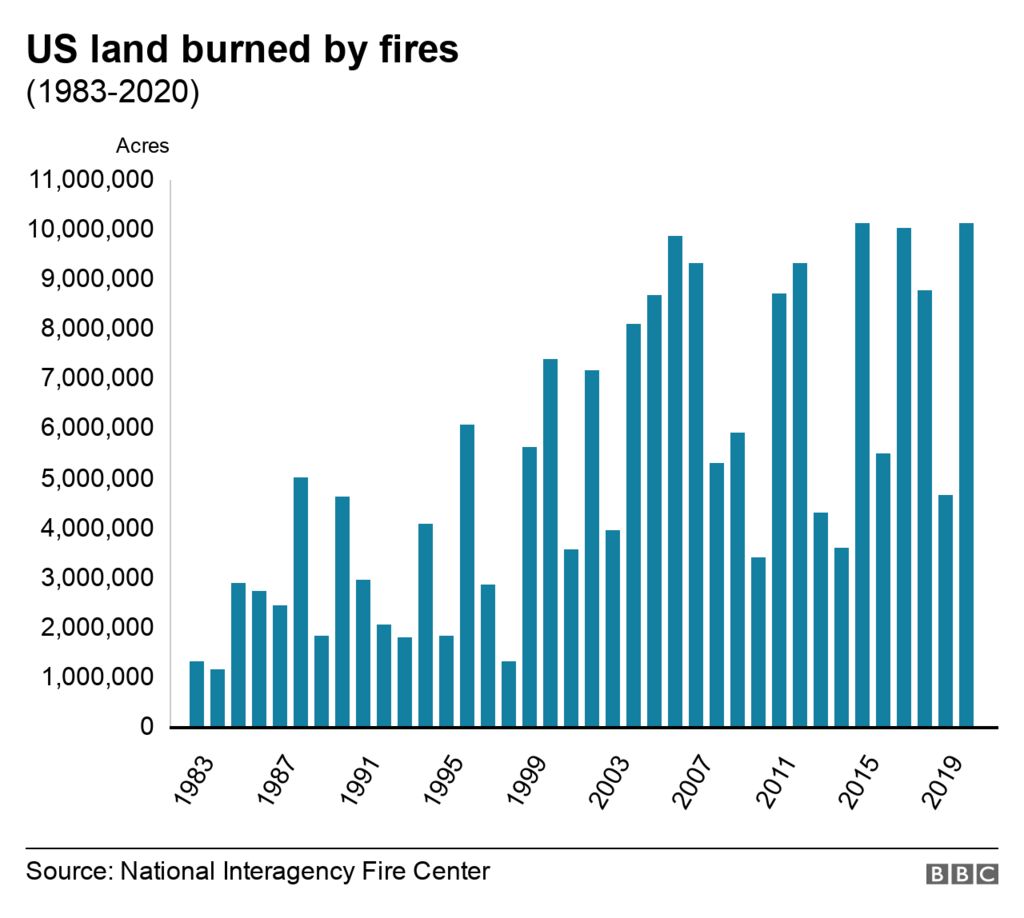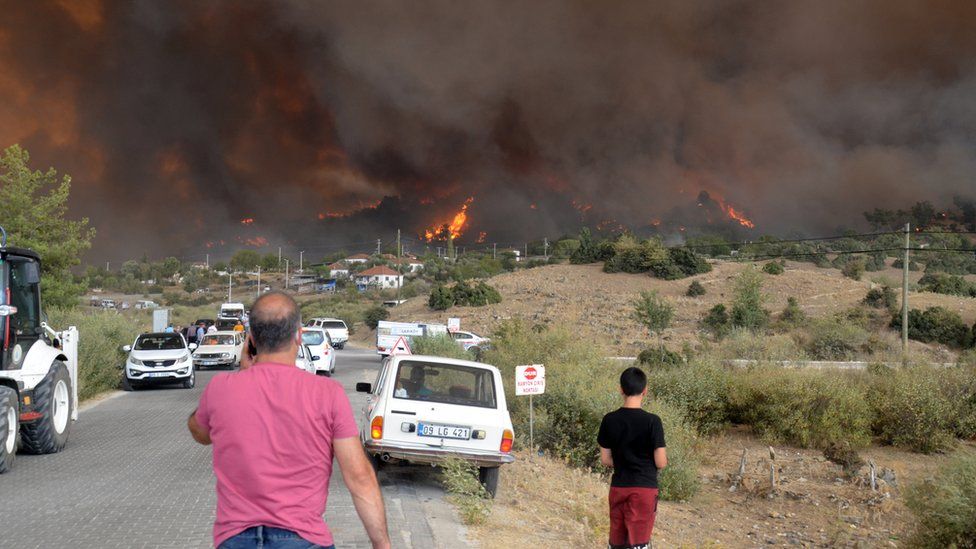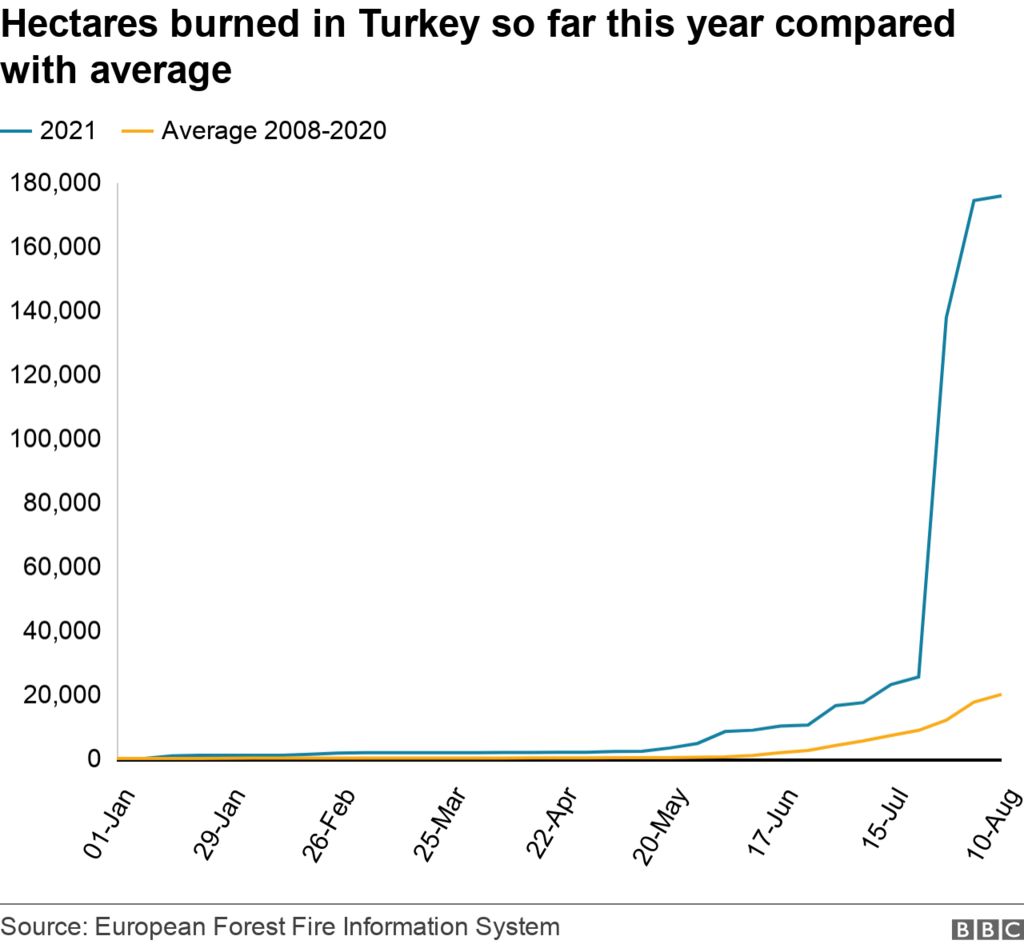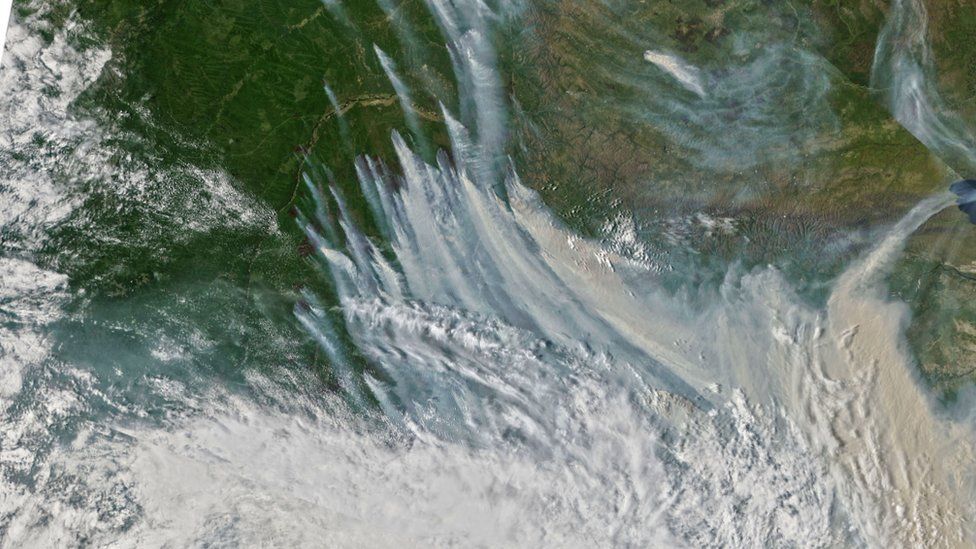BBC News Reality Check 12 August 2021 - by Jack Goodman and Jake Horton
Recent heatwaves and wildfires around the world have caused alarm - with warnings that parts of Europe and North America could be experiencing the worst fire season ever.
California hit hard
Parts of the western US have seen record-breaking temperatures this year, which - along with severe drought conditions - have triggered a series of major wildfires.
So far this year in California, more than twice as many acres of land have been burned by wildfires compared with the five-year average.
Dr Susan Prichard, from the School of Environmental and Forest Sciences at the University of Washington, says: "We now have the conflagrations in California that we feared, following the record-setting heatwaves.
"Given that California wildfires have burned all the way into November in recent years, I'm afraid that we might be set up for another record-breaking fire season."
Across the United States, more than 3.5 million acres have been burned so far this year.
That's one million more than at this point in the 2020 fire season - which ended as the most destructive season on record.
The acres burned across the US in 2021 so far sit below the 10-year average, with some other states not being as badly hit as California.
But experts are warning it is still very early, in what is looking like an exceptionally dry and long fire season.
Climate change increases the risk of the hot, dry weather that is likely to fuel wildfires.
Dr Prichard says: "Extreme fire weather events including increased lightning and strong winds, are also becoming more common under climate change."
Turkey fires 'worst in its history'
The wildfires in Turkey have been labelled 'the worst in its history' by President Recep Tayyip Erdogan.
More than 200 have affected western and southern Turkey, although the authorities say the majority of these are now contained.
About 175,000 hectares have been burned so far this year, according to the European Forest Fire Information System.
That's more than eight times the average for this time of year - measured between 2008 and 2020.
Dr Yusuf Serengil, from the Faculty of Forestry at the University of Istanbul, says: "It's a very bad year all over the Mediterranean region. We believe that this is caused by an above-average hot July in the region."
The Turkish authorities have been criticised for being caught off-guard by the recent fires, and not having enough planes to help tackle them.
They eventually received help from France, Spain and several other nations which provided air support.
Greece has also seen record-breaking wildfires - with 12 times as much land being burned than average.
Much of this destruction has been caused by wildfires on the Greek island of Evia, with more than 2,000 people being evacuated by sea.
There are also active wildfires in the Peloponnese region, in between the cities of Kalamata and Patras.
Siberia ablaze
Thick smoke from forest fires has blanketed parts of Siberia, and satellites have tracked it drifting to the Arctic Circle and beyond.
Blazes in Siberia occur every summer, starting in the south - around the Chinese-Mongolian border - before gradually moving north towards the remote Arctic Circle, where the fires are difficult to reach.
This fire season has seen smoke from Siberia reach the North Pole for the first time in recorded history.
And there are other signs they are getting worse. The average burnt area in Siberia for the last decade (2011-2020) was more than double the previous one, according to data from the Sukachev Forest Institute.
The Sakha Republic (or Yakutia) in the north-east has faced severe fires since mid-June. This type of high intensity fire emits more carbon dioxide.
The volume of carbon released by fires in Sakha this year far exceeds recent years. However, some neighbouring regions haven't endured such a bad season.
Scientists say that warmer and drier conditions in northern parts of Siberia increase the fire risk. And that human-caused climate change is a key factor in more extreme fire activity there.
A study found Siberia's record breaking heatwave in 2020 was impossible without climate change.
What's happening in the Amazon?
The Brazilian Amazon is closely monitored, as deforestation and fires linked to agriculture threaten this valuable ecosystem. It's still early in the country's annual fire season, which tends to peak in August and September.
So far in 2021, the area burned is less than last year, according to satellite data analysed by Dr Michelle Kalamandeen, a tropical ecologist.
But the Cerrado, a vast grassland or savannah used to farm crops and cattle, has seen an increase in land affected by fires.
In 2020, fires were particularly destructive at the southern edge of the Amazon, such as in the states of Mato Grosso and Pará. Here the forest meets the more fire-prone savannah.
Current conditions and the rain forecast suggest another drought, meaning "we could see large fire conflagrations again in this region", says Kátia Fernandes, Assistant Professor at the University of Arkansas and the fires and drought theme lead for the SERVIR-Amazonia project.
In other sections of the rainforest in Brazil - and in Peru and Bolivia - a more "average" season is expected. Overall, forecasts suggest climate conditions will be less conducive to the type of severe fires seen in 2020.
Human activities such as deforestation also pose a major fire risk.
Deforestation levels remain high, which could provide fuel for fires when the weather becomes drier.
And alongside these human activities, the impact of climate change on the Amazon is significant, says Prof Fernandes.
"We have seen evidence the dry season has increased in length, and severe droughts are occurring more frequently due to natural variability exacerbated by climate change."









